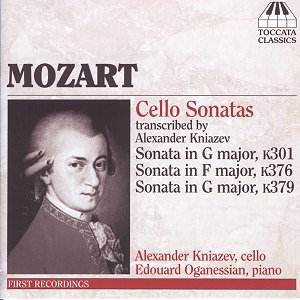Given that he wrote 34 violin sonatas,
it was very remiss of Mozart not to
write any for the cello. My prior biases
here were pro-cello and pro-transcription
but, after listening to this disc, I
returned to my Perlman/Barenboim set
of the works in their original guise
and enjoyed that much more. Perlman
and Barenboim are hardly extreme authenticity
merchants but at least I didn’t spend
K379 wondering whether it was one of
Beethoven’s "WoO"s - and their
playing is fabulous too. The liner of
this disc suggests that the transcriptions
"transform the works ... the cello
brings out the rich proto-Romantic sonorities
implicit in the music". I am rather
sceptical of this and doubt that the
transformation is intrinsic to the transcriptions
– it is probably more a question of
Kniazev’s playing style than what he
did on paper. At least, though, the
labelling warns you what adverse effects
to expect.
Kniazev’s Beethovenian
approach is most obvious in K379 with
a very slow tempo for the adagio introduction
leading to a first movement lasting
14 minutes (Perlman/Barenboim take less
than 8 minutes). So un-Mozart like is
the beginning of this work that when
I played this "blind" to my
wife – a better guesser of composers
than me – Brahms came back and my amusement
was not directed at her! Matters improve
a little in the second movement of two.
This is based on a theme with five variations
but the documentation errs in missing
this out altogether on the track listing
(I. Adagio II. Allegro
is given instead of I. Adagio -
Allegro).
The other G major sonata
(K301) comes from an earlier period
and is also in two movements. Much less
inflation is applied here and I quite
enjoyed this. The final work, in F major,
comes somewhere between the two in approach
and it is the central andante that sounds
least Mozartian. If I sound critical
of the players it should be understood
that this relates entirely to matters
of style. There is much fine playing
by both artists and they make a good
duo – the piano part being equally important
in these works.
The recordings are
a few years old and sound well if a
little "upfront". The documentation
is handsome apart from the blot mentioned
above.
Others may tolerate
or even enjoy Kniazev’s approach to
this music more than me but it is hard
to escape the feeling that this is Mozart
dressed up as Beethoven (or even Brahms!).
Patrick C Waller


